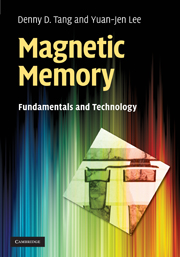Book contents
- Frontmatter
- Contents
- Preface
- Acknowledgments
- 1 Basic electromagnetism
- 2 Magnetic films
- 3 Properties of patterned ferromagnetic films
- 4 Magnetoresistance effects
- 5 Field-write mode MRAMs
- 6 Spin-torque-transfer mode MRAM
- 7 Applications of MTJ-based technology
- Appendix A Unit conversion table for cgs and SI units
- Appendix B Dimensions of units of magnetism
- Appendix C Physical constants
- Appendix D Gaussian distribution and quantile plots
- Appendix E Weibull distribution
- Appendix F Time-dependent dielectric breakdown (TDDB) of magnetic tunnel junction devices
- Appendix G Binomial distribution and Poisson distribution
- Appendix H Defect density and the breakdown/TMR distribution of MTJ devices
- Appendix I Fe, Ni and Co material parameters
- Appendix J Soft error, hard fail and design margin
- Index
- References
6 - Spin-torque-transfer mode MRAM
Published online by Cambridge University Press: 06 July 2010
- Frontmatter
- Contents
- Preface
- Acknowledgments
- 1 Basic electromagnetism
- 2 Magnetic films
- 3 Properties of patterned ferromagnetic films
- 4 Magnetoresistance effects
- 5 Field-write mode MRAMs
- 6 Spin-torque-transfer mode MRAM
- 7 Applications of MTJ-based technology
- Appendix A Unit conversion table for cgs and SI units
- Appendix B Dimensions of units of magnetism
- Appendix C Physical constants
- Appendix D Gaussian distribution and quantile plots
- Appendix E Weibull distribution
- Appendix F Time-dependent dielectric breakdown (TDDB) of magnetic tunnel junction devices
- Appendix G Binomial distribution and Poisson distribution
- Appendix H Defect density and the breakdown/TMR distribution of MTJ devices
- Appendix I Fe, Ni and Co material parameters
- Appendix J Soft error, hard fail and design margin
- Index
- References
Summary
Introduction
The best description of spin-torque transfer can be found in the patent issued to John Slonczewski of IBM:
It is a fundamental fact that the macroscopic magnetization intensity of a magnet such as iron arises from the cooperative mutual alignment of elementary magnetic moments carried by electrons. An electron is little more than a mass particle carrying an electrostatic charge, which spins at a constant rate, like a planet about its axis. The electric current of this spin induces a surrounding magnetic field distribution resembling that which surrounds the Earth. Thus, each electron is effectively a miniscule permanent magnet…
… The exchange interaction is that force, arising quantum-mechanically from electrostatic interactions between spinning electrons, which causes this mutual alignment … Not only does it couple the bound spins of a ferromagnet to each other, but it also couples the spins of moving electrons, such as those partaking in current flow, to these bound electrons.
The subject of spin-torque transfer was not widely known until 1996. Due to its enormous technology potential, both academic and industrial research activities had been very active, and very rapid progresses have been made in recent years: from the first experimental verification of spin-torque transfer in giant magnetoresistance (GMR) film, to the implementation of this mechanism to magnetic tunneling junction devices. A large portion of this effort was directed towards the development of practical magnetic RAM chips based on the spin-torque-transfer mechanism.
- Type
- Chapter
- Information
- Magnetic MemoryFundamentals and Technology, pp. 122 - 164Publisher: Cambridge University PressPrint publication year: 2010
References
- 9
- Cited by

